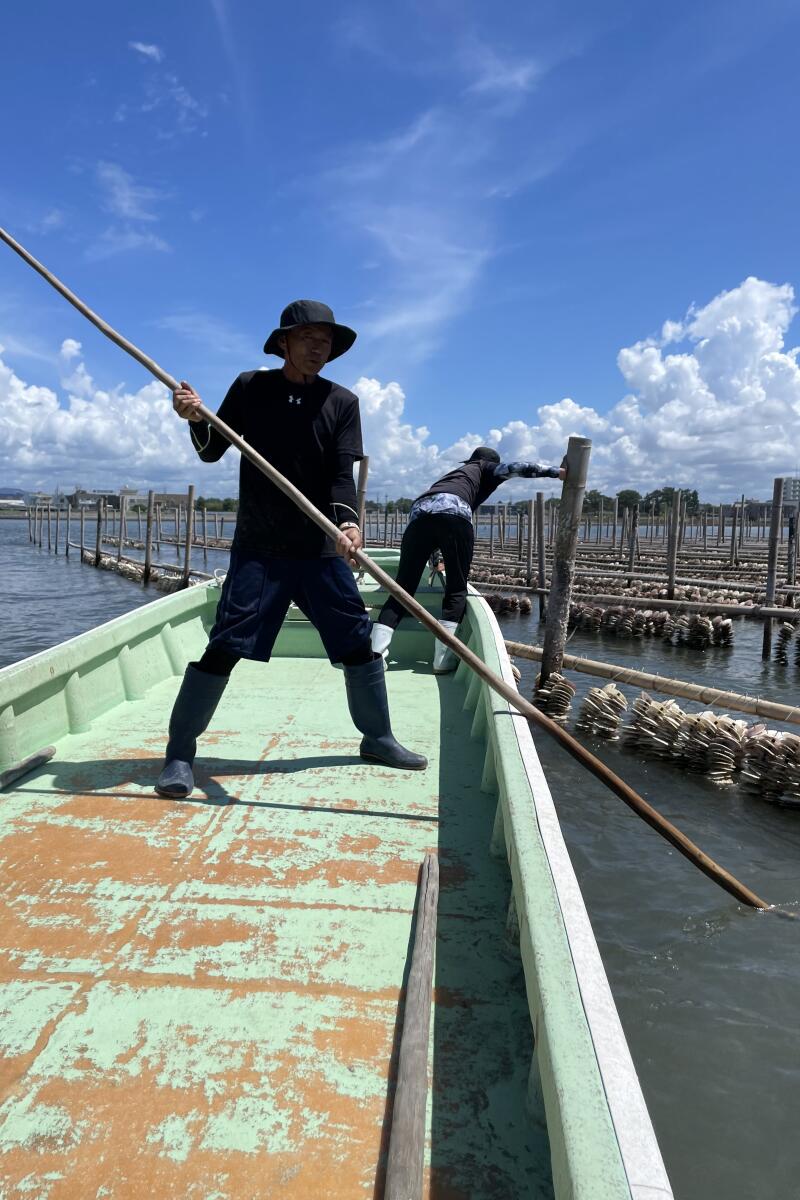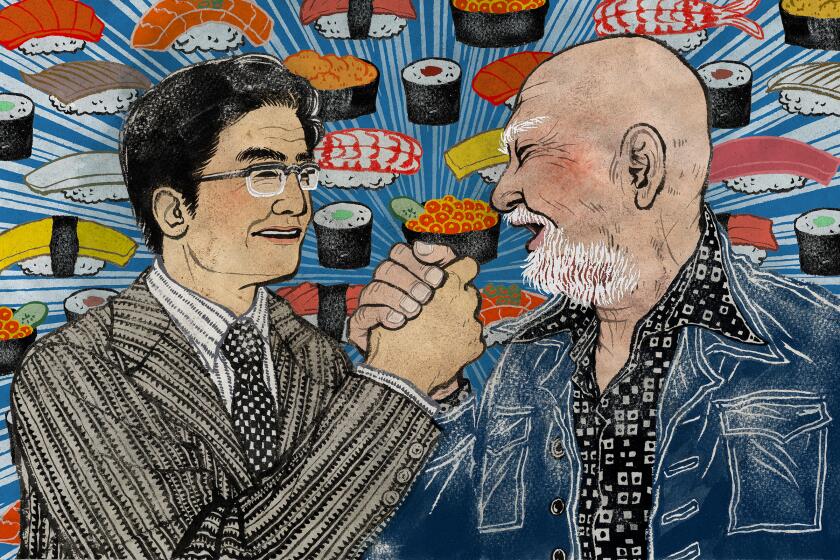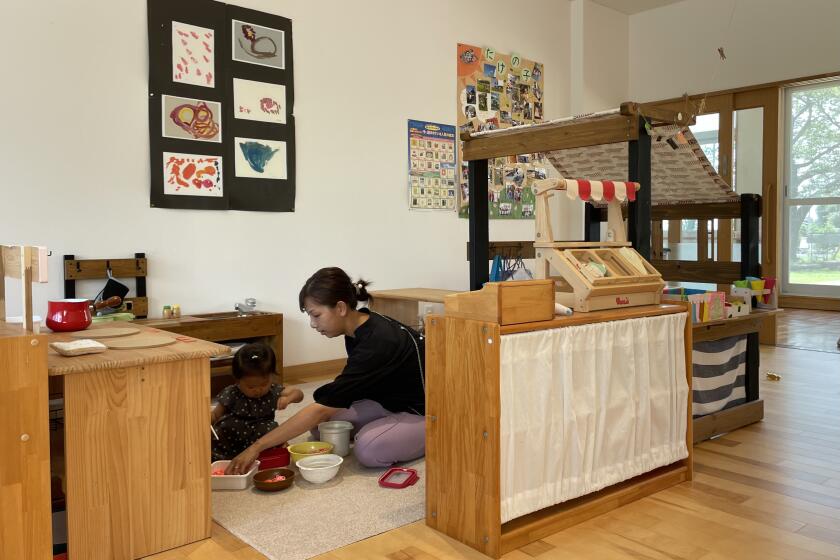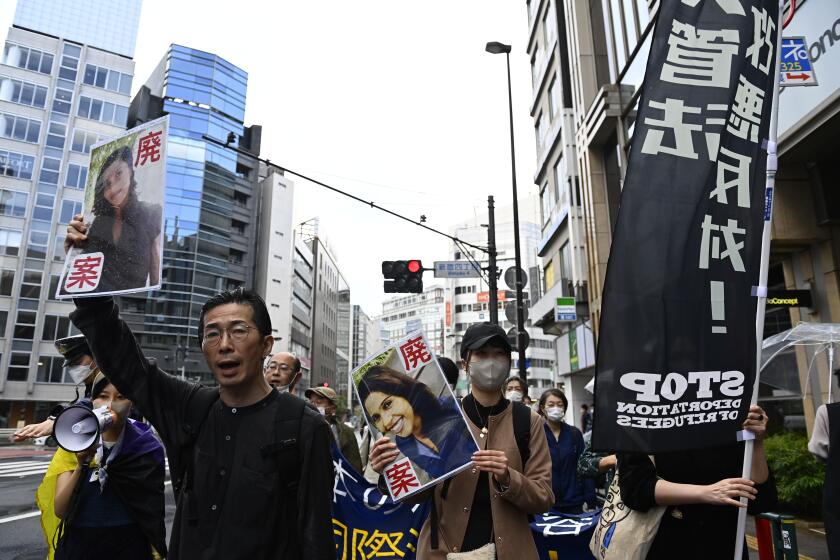
- Share via
MAISAKA, Japan — Every year, as July draws to a close, Norio Terada and his fellow oyster farmers submerge hundreds of scallop shells strung on wire rings into the waters of Lake Hamana.
The tiny black larvae that attach to the shells will be harvested from the salty lagoon in about 18 months as full-grown oysters. But first they have to survive an increasingly hostile marine environment that in recent years has withered production and rattled fishermen around the country.
“Oyster farming has a history of more than 100 years. But this is the first time I’ve observed this much death,” said Terada, 64. A particularly devastating season three years ago yielded only one-tenth his usual intake.
One critical threat is warmer waters, which stunt the growth of oysters and other aquatic organisms as oxygen levels decline. The average temperature of the world’s ocean surface reached a record high in August, according to the U.S. National Oceanic and Atmospheric Administration, with marine heat waves pushing some areas near 100 degrees this summer.

The change in sea temperatures is also scrambling the migration patterns and behavior of underwater creatures, which means that blackhead sea breams here in coastal Maisaka are becoming more active during the winter months and feeding on Terada’s juvenile oysters.
It’s not just Terada who’s struggling with scarcity. Four decades ago, this sushi-loving country was one of the largest fishing nations in the world, catching more than 12 million tons annually in the 1980s. But Japan’s haul has steadily declined over the last 10 years, falling to a record low in 2022 of 3.85 million tons, down 7.5% from the previous year.
As fish make for cooler climates, some species such as the Pacific saury and flying squid are moving farther into open waters and out of the reach of Japanese fishermen, particularly as fuel prices rise. Others traditionally caught off Japan’s southern shores, like yellowtail or Spanish mackerel, are reappearing in northern waters, according to industry groups. Oftentimes, those fish have to be shipped back south to the regions more familiar with preparing them for consumption.
The subsequent rise in fresh seafood costs is hitting Japanese consumers and merchants hard. In May, food inflation hit a 47-year high, with the price of fish climbing 14.8% compared with a year earlier and outpacing an 8.6% rise in meat prices.
“The response of the ecosystem is changing. It’s becoming very difficult to predict which kinds of species will increase,” said Shin-ichi Ito, a professor with the Atmosphere and Ocean Research Institute at the University of Tokyo. “Fishermen can adapt. But for the food industry — fish produce, seafood materials — it is very hard to adjust because most of the companies are very small.”

Oyster farmers work in Lake Hamana in Maisaka, Japan. (Stephanie Yang / Los Angeles Times)

Farmer Norio Terada lifts oysters out of the water in Maisaka, Japan. (Stephanie Yang / Los Angeles Times)
In 2021, Japan’s fishing and aquaculture industry generated about $9.5 billion. That year, the Ministry of Agriculture, Forestry and Fisheries launched a plan to restore fishery production back to 2010 levels of 4.44 million tons by 2030 and boost breeding of new and strategic species such as grouper and yellowtail.
The ministry’s Fisheries Agency said it would also aim to offset the impact of climate change by promoting the electrification of fishing vehicles, the farming of species with higher heat tolerance and the development of strategies to help juvenile salmon survive harsher environments.
“The government has to change the structure of fisheries assuming that almost no salmon or saury can be caught in the waters around Japan,” said Takahisa Yamamoto, the agency’s assistant director of policy planning, singling out two fish experiencing the steepest catch declines over the last decade. “As long as climate change continues, we cannot think of a best-case scenario.”
An unlikely pair of Southern California businessmen paved the way for the sushi revolution in Los Angeles, upending American dining — and their own lives.
Changes in the natural environment are not limited to temperatures. Some fishermen bemoan more frequent regional red tides, toxic blooms of phytoplankton that can harm sea creatures. Fluctuations in significant ocean currents around Japan can also affect water temperatures and the activity of local species.
Others blame the declining catches on human intervention such as overfishing, which the government is trying to curb through tightened quotas, or Japan’s rigorous filtration system, which returns seawater to the ocean without nutrients vital for marine life.
Given the various factors and complex underwater food chain, some researchers are hesitant to point to global heating and warmer waters as the sole cause of dwindling catches.
Our oceans. Our public lands. Our future.
Get Boiling Point, our new newsletter exploring climate change and the environment, and become part of the conversation — and the solution.
You may occasionally receive promotional content from the Los Angeles Times.
“The ecosystem is very complicated. There’s not enough evidence to prove this correlation,” said Hirofumi Washiyama, chief researcher at the Shizuoka Institute of Fisheries and Marine Technology.
Japan’s fishing industry has always borne the risks of natural phenomena. The existential threat of climate change, by comparison, feels more dire than tsunamis or changing tides in Maisaka, where many are doubtful the Japanese government will be able to offer much help.
“This issue needs to be addressed by the whole world. It’s on a global scale,” said Terada, the oyster farmer.
Meanwhile, fishermen are devising their own methods to offset catch declines. A few years ago, Terada and others started hanging nets around the bamboo racks where they cultivate their oysters to keep sea bream away, a technique gleaned from other farming towns nearby.

Several miles away, clam fishermen have tested similar measures to prevent sea bream from eating their potential harvest, too, stringing mesh across poles in a small patch of shallow water. But they found that the material tore too easily, leaving the net riddled with holes.
This year, they switched to a flat wire net, laid atop a batch of young clams collected from around Lake Hamana and placed in the water three weeks before. On a blistering August afternoon, Yusuke Kawai, 42, unpinned the metal netting and gathered the clams in his hands for inspection. Many were already dead.
The netting had proved effective at deterring the sea bream as well as predatory sea snails. But Kawai had a feeling they placed the clams too late in the day, exposing them to the searing afternoon heat before they could escape by burrowing into the sand.
Japan is confronting a depopulation crisis because of a precipitously falling birth rate, but one mountain town has bucked the trend — spectacularly.
“At that time, it was like a hot bath,” he said, estimating the water temperature to be near 86 degrees.
A decade earlier, clams were so plentiful in the lake that tourists would come to harvest them. Even five years ago, clams accounted for about half of Kawai’s annual catch.
But over the last two years, his haul has dwindled to nearly nothing. Now, he’s supplementing his income by fishing anchovies and growing laver, the edible fronds of seaweed that make nori, another staple of Japanese cuisine commonly used in sushi rolls. He started learning how to raise glass eels last year as well.
The Fisheries Agency is trying to help fishermen adjust to shifts in marine life by teaching them to go after different kinds of fish, which requires their time and money to learn unfamiliar techniques with new equipment. Even then, some species aren’t worth the investment.
In Japan, a nation reputed for loyalty to companies and lifetime employment, people who job-hop are often viewed as quitters.
In Maisaka, there’s little incentive to switch to sea bream, even as their numbers rise. They bring in only a fraction of the money that fishermen can make from other species, since the taste is less desirable — though the local government is doing its best to encourage people to eat more, working with processors of dried food and with restaurants to devise new offerings.
The national government is promoting seaweed production as well. But even that has become more challenging as temperatures rise.
In Kasaoka, a port city on the Seto Inland Sea, Yuki Senoo and his father run one of the two last nori producers left in town. When Senoo’s grandfather started growing laver half a century ago, there were about 50 local operators. But increasing capital costs and an aging population led most of them to close up shop.
Now, Senoo’s business is under pressure as the seas turn hotter. Starting in September, nori cultivators attach laver seeds to a large net spread across the ocean surface for harvest from November to April. Warmer weather in the fall and spring is shortening that production season, since higher temperatures can warp the plants and leave them more susceptible to disease.
Japan is desperate for foreign workers — yet it’s cracking down on uninvited asylum seekers who are desperate for employment.
Four years ago, the Senoos started growing a new type of seaweed called iwanori that has proved more resistant to high water temperatures than their traditional strain, susabi. Iwanori currently accounts for about 10% of production, but Senoo said the company must increase that proportion in order to survive. He and his father have also started constructing a sprawling nylon net this year to keep the growing population of sea bream at bay.
Before Senoo returned to Kasaoka to work in the family business, his father had planned on closing it by the time he turned 65, a milestone reached three years ago. Senoo’s sons, 8 and 11, have told him they’re interested in eventually running the company, but he’s reluctant to let them shackle themselves to such an uncertain future.
“Their environment is going to be worse than mine,” he said. “I can’t imagine what the world is going to look like in five to 10 years.”
More to Read
Sign up for Essential California
The most important California stories and recommendations in your inbox every morning.
You may occasionally receive promotional content from the Los Angeles Times.


















